Adoption of Telehealth Technology by Primary Care Providers
VerifiedAdded on 2022/08/16
|106
|29863
|25
Thesis and Dissertation
AI Summary
This doctoral dissertation investigates the adoption of telehealth technology among primary care providers, focusing on those in community hospitals within the United States. The study employs the Technology Acceptance Model (TAM) to identify factors influencing the low acceptance rate of telehealth. The research explores the relationship between perceived usefulness, perceived ease of use, organizational support, and the behavioral intention to use telehealth technology. The dissertation includes an introduction to the problem, a literature review of existing research, the methodology used (quantitative correlational study), findings, and implications. The study aims to provide insights that can encourage hospital administrators to create successful telehealth programs and improve the implementation rates of telehealth in community hospitals. The research highlights the importance of understanding the factors that influence the acceptance of new technologies among end-users, which is crucial for the effective delivery of healthcare.
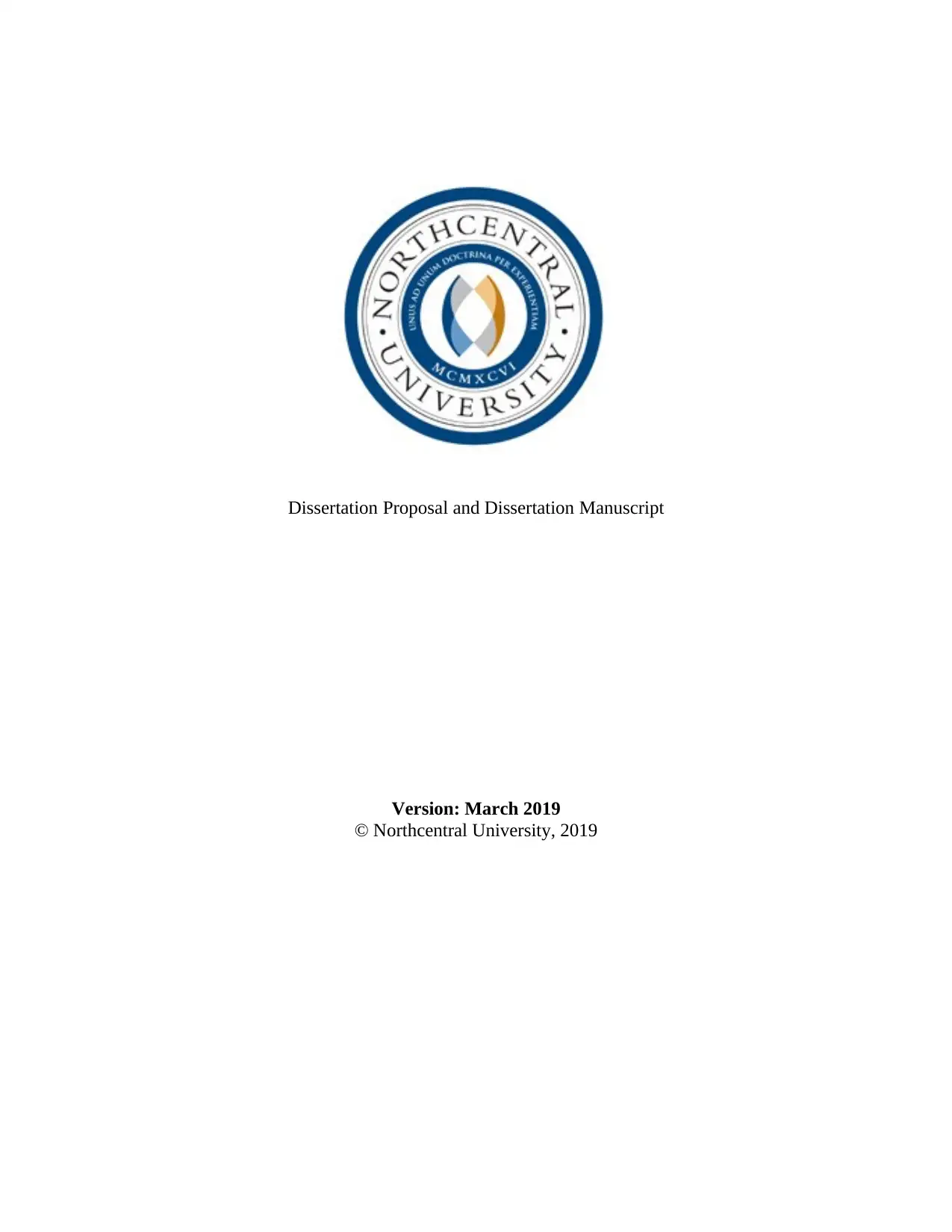
Dissertation Proposal and Dissertation Manuscript
Version: March 2019
© Northcentral University, 2019
Version: March 2019
© Northcentral University, 2019
Paraphrase This Document
Need a fresh take? Get an instant paraphrase of this document with our AI Paraphraser
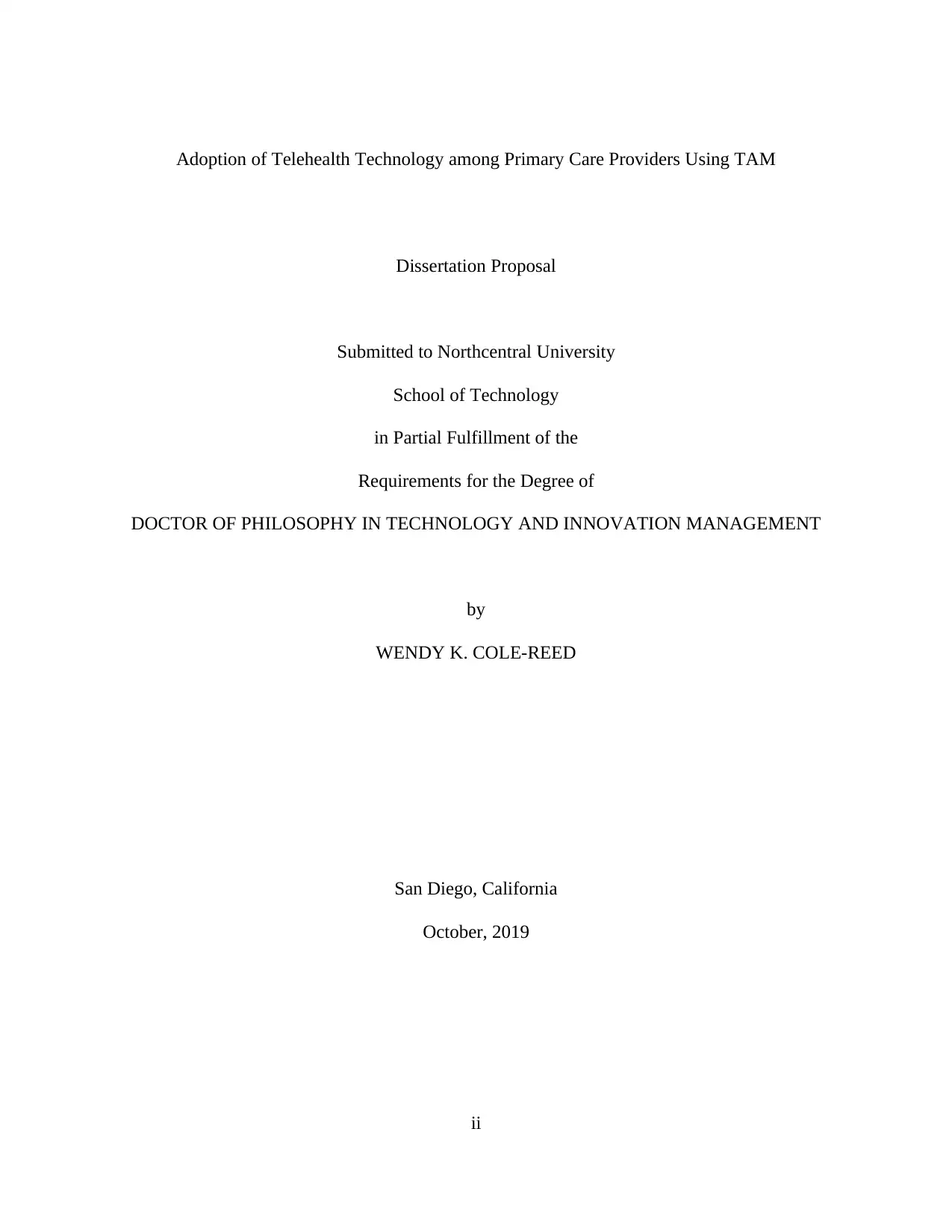
Adoption of Telehealth Technology among Primary Care Providers Using TAM
Dissertation Proposal
Submitted to Northcentral University
School of Technology
in Partial Fulfillment of the
Requirements for the Degree of
DOCTOR OF PHILOSOPHY IN TECHNOLOGY AND INNOVATION MANAGEMENT
by
WENDY K. COLE-REED
San Diego, California
October, 2019
ii
Dissertation Proposal
Submitted to Northcentral University
School of Technology
in Partial Fulfillment of the
Requirements for the Degree of
DOCTOR OF PHILOSOPHY IN TECHNOLOGY AND INNOVATION MANAGEMENT
by
WENDY K. COLE-REED
San Diego, California
October, 2019
ii

Abstract
iii
iii
⊘ This is a preview!⊘
Do you want full access?
Subscribe today to unlock all pages.

Trusted by 1+ million students worldwide

Acknowledgements
Begin writing here…
iv
Begin writing here…
iv
Paraphrase This Document
Need a fresh take? Get an instant paraphrase of this document with our AI Paraphraser
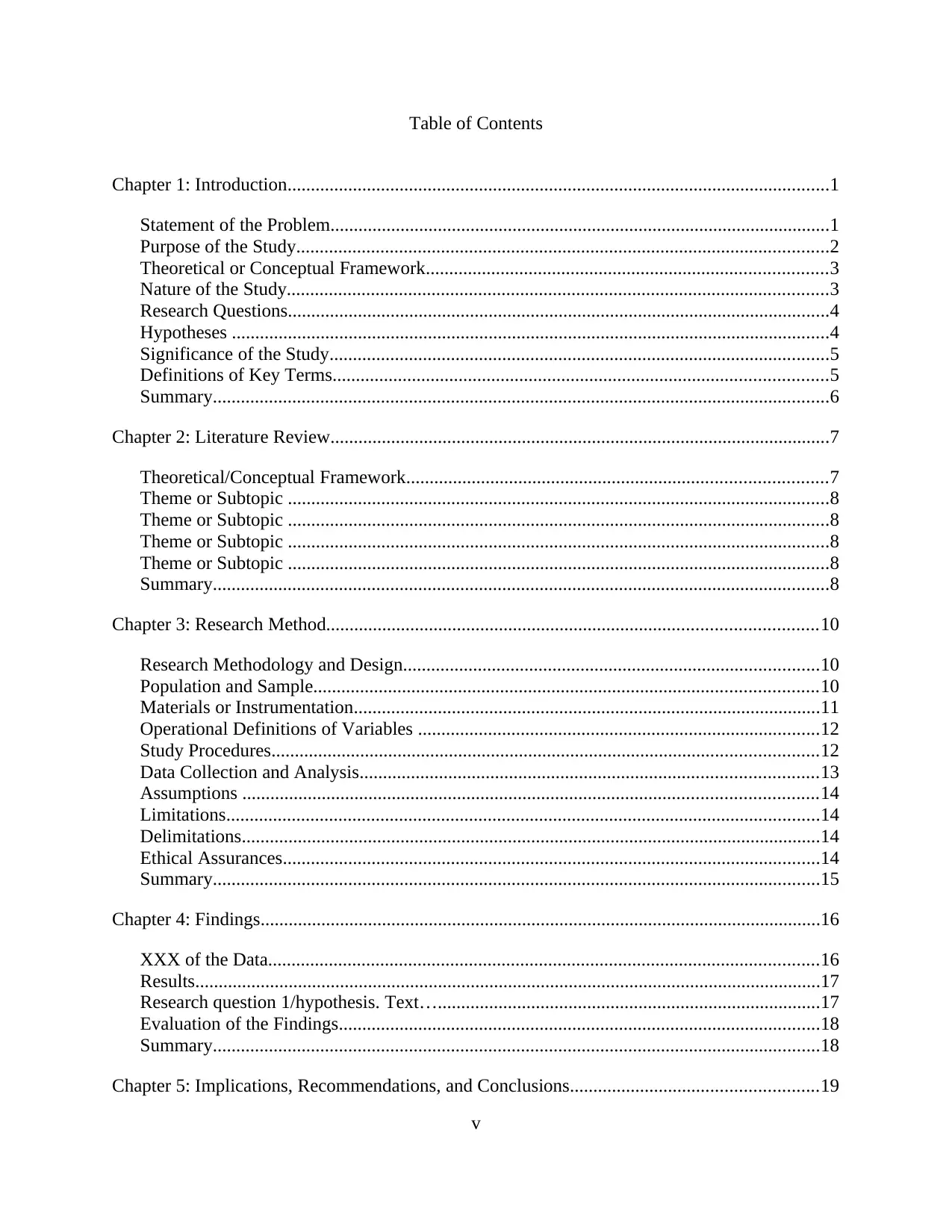
Table of Contents
Chapter 1: Introduction....................................................................................................................1
Statement of the Problem...........................................................................................................1
Purpose of the Study..................................................................................................................2
Theoretical or Conceptual Framework......................................................................................3
Nature of the Study....................................................................................................................3
Research Questions....................................................................................................................4
Hypotheses ................................................................................................................................4
Significance of the Study...........................................................................................................5
Definitions of Key Terms..........................................................................................................5
Summary....................................................................................................................................6
Chapter 2: Literature Review...........................................................................................................7
Theoretical/Conceptual Framework..........................................................................................7
Theme or Subtopic ....................................................................................................................8
Theme or Subtopic ....................................................................................................................8
Theme or Subtopic ....................................................................................................................8
Theme or Subtopic ....................................................................................................................8
Summary....................................................................................................................................8
Chapter 3: Research Method.........................................................................................................10
Research Methodology and Design.........................................................................................10
Population and Sample............................................................................................................10
Materials or Instrumentation....................................................................................................11
Operational Definitions of Variables ......................................................................................12
Study Procedures.....................................................................................................................12
Data Collection and Analysis..................................................................................................13
Assumptions ...........................................................................................................................14
Limitations...............................................................................................................................14
Delimitations............................................................................................................................14
Ethical Assurances...................................................................................................................14
Summary..................................................................................................................................15
Chapter 4: Findings........................................................................................................................16
XXX of the Data......................................................................................................................16
Results......................................................................................................................................17
Research question 1/hypothesis. Text…..................................................................................17
Evaluation of the Findings.......................................................................................................18
Summary..................................................................................................................................18
Chapter 5: Implications, Recommendations, and Conclusions.....................................................19
v
Chapter 1: Introduction....................................................................................................................1
Statement of the Problem...........................................................................................................1
Purpose of the Study..................................................................................................................2
Theoretical or Conceptual Framework......................................................................................3
Nature of the Study....................................................................................................................3
Research Questions....................................................................................................................4
Hypotheses ................................................................................................................................4
Significance of the Study...........................................................................................................5
Definitions of Key Terms..........................................................................................................5
Summary....................................................................................................................................6
Chapter 2: Literature Review...........................................................................................................7
Theoretical/Conceptual Framework..........................................................................................7
Theme or Subtopic ....................................................................................................................8
Theme or Subtopic ....................................................................................................................8
Theme or Subtopic ....................................................................................................................8
Theme or Subtopic ....................................................................................................................8
Summary....................................................................................................................................8
Chapter 3: Research Method.........................................................................................................10
Research Methodology and Design.........................................................................................10
Population and Sample............................................................................................................10
Materials or Instrumentation....................................................................................................11
Operational Definitions of Variables ......................................................................................12
Study Procedures.....................................................................................................................12
Data Collection and Analysis..................................................................................................13
Assumptions ...........................................................................................................................14
Limitations...............................................................................................................................14
Delimitations............................................................................................................................14
Ethical Assurances...................................................................................................................14
Summary..................................................................................................................................15
Chapter 4: Findings........................................................................................................................16
XXX of the Data......................................................................................................................16
Results......................................................................................................................................17
Research question 1/hypothesis. Text…..................................................................................17
Evaluation of the Findings.......................................................................................................18
Summary..................................................................................................................................18
Chapter 5: Implications, Recommendations, and Conclusions.....................................................19
v
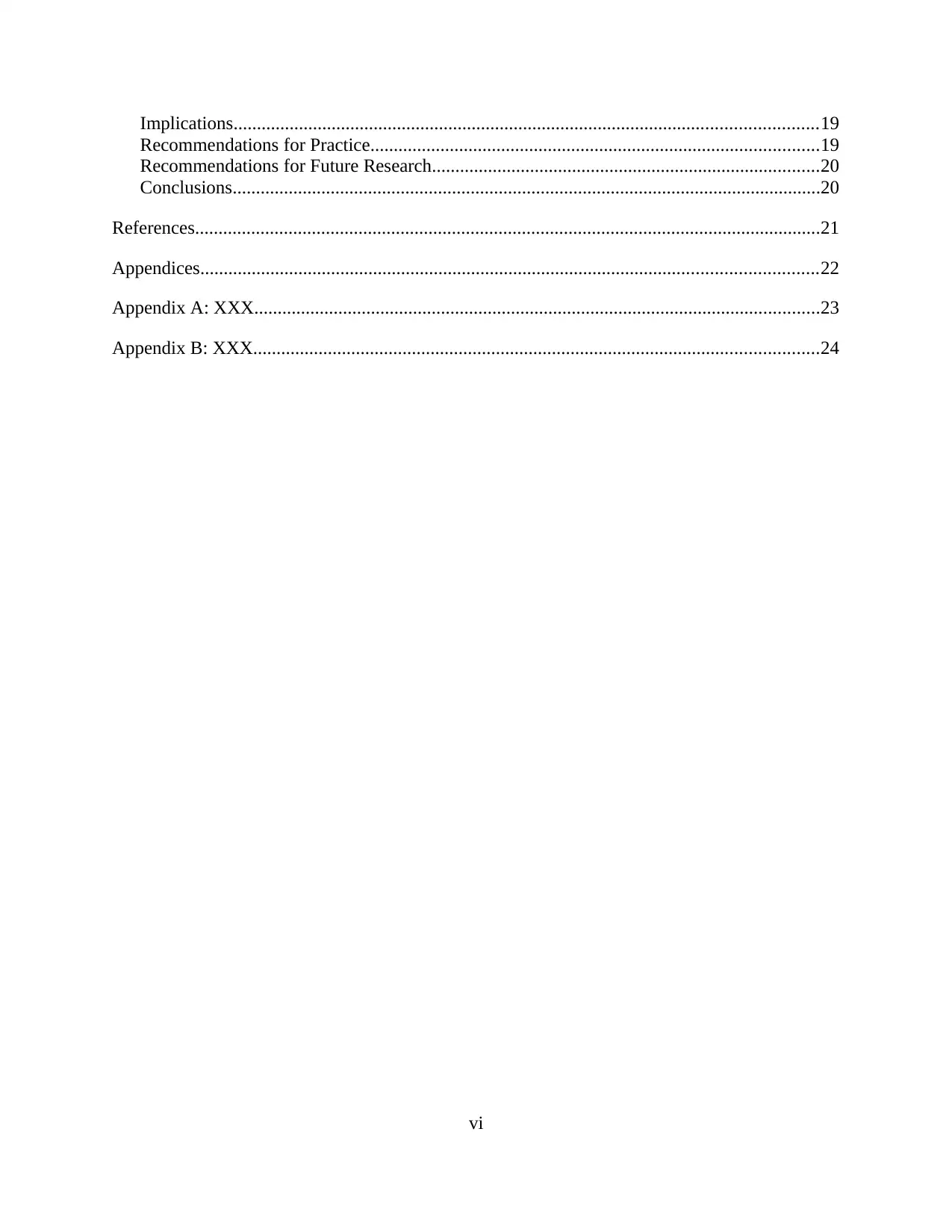
Implications.............................................................................................................................19
Recommendations for Practice................................................................................................19
Recommendations for Future Research...................................................................................20
Conclusions..............................................................................................................................20
References......................................................................................................................................21
Appendices....................................................................................................................................22
Appendix A: XXX.........................................................................................................................23
Appendix B: XXX.........................................................................................................................24
vi
Recommendations for Practice................................................................................................19
Recommendations for Future Research...................................................................................20
Conclusions..............................................................................................................................20
References......................................................................................................................................21
Appendices....................................................................................................................................22
Appendix A: XXX.........................................................................................................................23
Appendix B: XXX.........................................................................................................................24
vi
⊘ This is a preview!⊘
Do you want full access?
Subscribe today to unlock all pages.

Trusted by 1+ million students worldwide

List of Tables
Begin list of tables here…
vii
Begin list of tables here…
vii
Paraphrase This Document
Need a fresh take? Get an instant paraphrase of this document with our AI Paraphraser

List of Figures
Begin list of figures here…
viii
Begin list of figures here…
viii
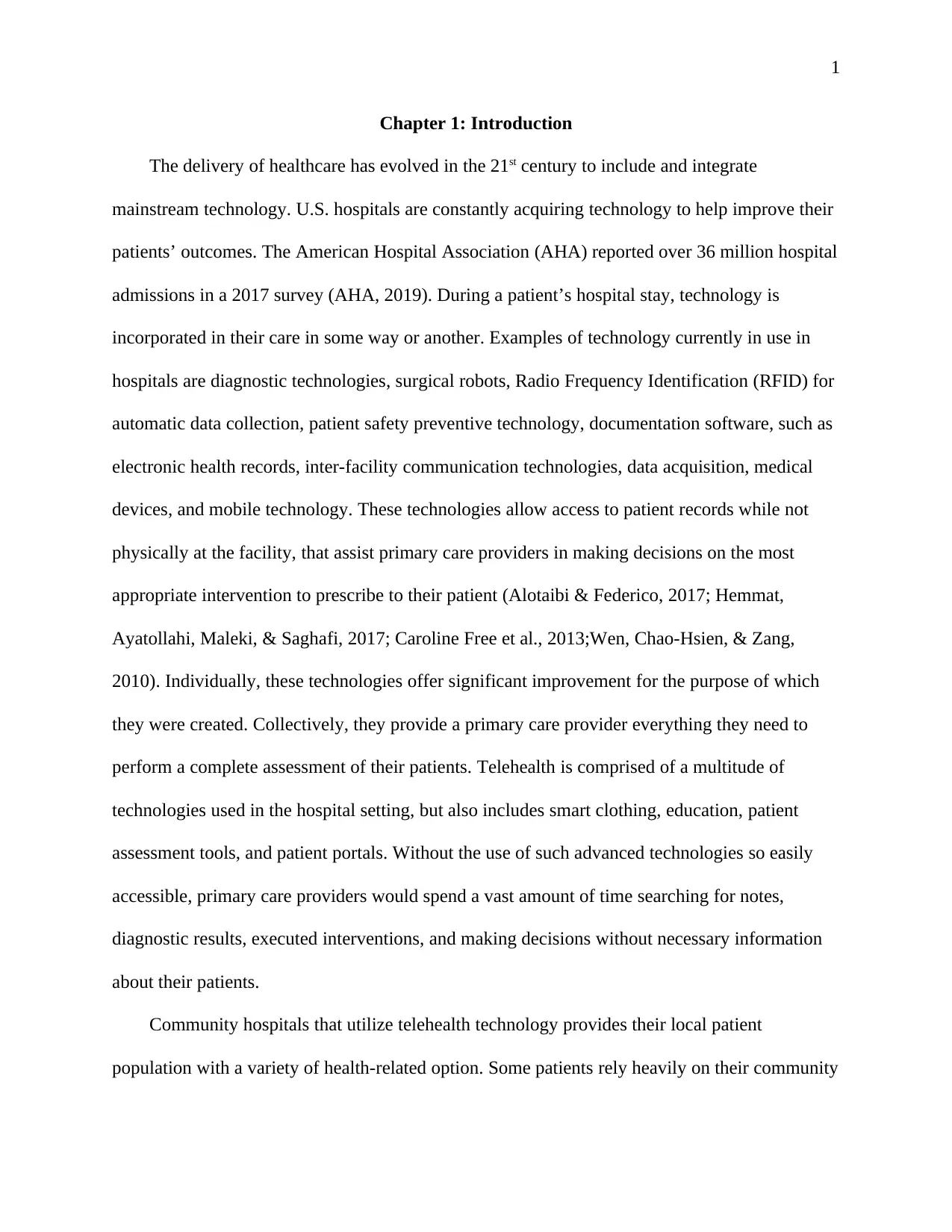
1
Chapter 1: Introduction
The delivery of healthcare has evolved in the 21st century to include and integrate
mainstream technology. U.S. hospitals are constantly acquiring technology to help improve their
patients’ outcomes. The American Hospital Association (AHA) reported over 36 million hospital
admissions in a 2017 survey (AHA, 2019). During a patient’s hospital stay, technology is
incorporated in their care in some way or another. Examples of technology currently in use in
hospitals are diagnostic technologies, surgical robots, Radio Frequency Identification (RFID) for
automatic data collection, patient safety preventive technology, documentation software, such as
electronic health records, inter-facility communication technologies, data acquisition, medical
devices, and mobile technology. These technologies allow access to patient records while not
physically at the facility, that assist primary care providers in making decisions on the most
appropriate intervention to prescribe to their patient (Alotaibi & Federico, 2017; Hemmat,
Ayatollahi, Maleki, & Saghafi, 2017; Caroline Free et al., 2013;Wen, Chao-Hsien, & Zang,
2010). Individually, these technologies offer significant improvement for the purpose of which
they were created. Collectively, they provide a primary care provider everything they need to
perform a complete assessment of their patients. Telehealth is comprised of a multitude of
technologies used in the hospital setting, but also includes smart clothing, education, patient
assessment tools, and patient portals. Without the use of such advanced technologies so easily
accessible, primary care providers would spend a vast amount of time searching for notes,
diagnostic results, executed interventions, and making decisions without necessary information
about their patients.
Community hospitals that utilize telehealth technology provides their local patient
population with a variety of health-related option. Some patients rely heavily on their community
Chapter 1: Introduction
The delivery of healthcare has evolved in the 21st century to include and integrate
mainstream technology. U.S. hospitals are constantly acquiring technology to help improve their
patients’ outcomes. The American Hospital Association (AHA) reported over 36 million hospital
admissions in a 2017 survey (AHA, 2019). During a patient’s hospital stay, technology is
incorporated in their care in some way or another. Examples of technology currently in use in
hospitals are diagnostic technologies, surgical robots, Radio Frequency Identification (RFID) for
automatic data collection, patient safety preventive technology, documentation software, such as
electronic health records, inter-facility communication technologies, data acquisition, medical
devices, and mobile technology. These technologies allow access to patient records while not
physically at the facility, that assist primary care providers in making decisions on the most
appropriate intervention to prescribe to their patient (Alotaibi & Federico, 2017; Hemmat,
Ayatollahi, Maleki, & Saghafi, 2017; Caroline Free et al., 2013;Wen, Chao-Hsien, & Zang,
2010). Individually, these technologies offer significant improvement for the purpose of which
they were created. Collectively, they provide a primary care provider everything they need to
perform a complete assessment of their patients. Telehealth is comprised of a multitude of
technologies used in the hospital setting, but also includes smart clothing, education, patient
assessment tools, and patient portals. Without the use of such advanced technologies so easily
accessible, primary care providers would spend a vast amount of time searching for notes,
diagnostic results, executed interventions, and making decisions without necessary information
about their patients.
Community hospitals that utilize telehealth technology provides their local patient
population with a variety of health-related option. Some patients rely heavily on their community
⊘ This is a preview!⊘
Do you want full access?
Subscribe today to unlock all pages.

Trusted by 1+ million students worldwide
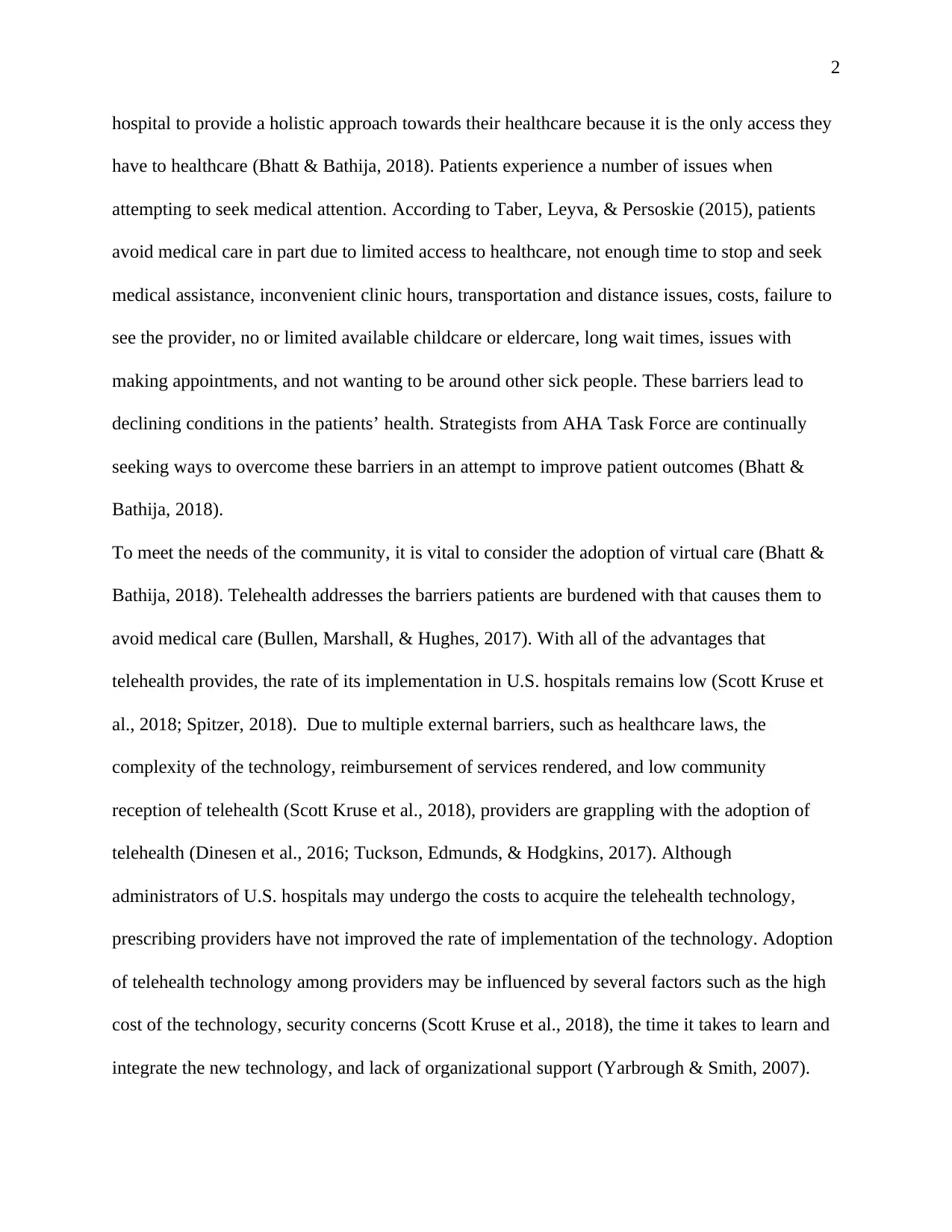
2
hospital to provide a holistic approach towards their healthcare because it is the only access they
have to healthcare (Bhatt & Bathija, 2018). Patients experience a number of issues when
attempting to seek medical attention. According to Taber, Leyva, & Persoskie (2015), patients
avoid medical care in part due to limited access to healthcare, not enough time to stop and seek
medical assistance, inconvenient clinic hours, transportation and distance issues, costs, failure to
see the provider, no or limited available childcare or eldercare, long wait times, issues with
making appointments, and not wanting to be around other sick people. These barriers lead to
declining conditions in the patients’ health. Strategists from AHA Task Force are continually
seeking ways to overcome these barriers in an attempt to improve patient outcomes (Bhatt &
Bathija, 2018).
To meet the needs of the community, it is vital to consider the adoption of virtual care (Bhatt &
Bathija, 2018). Telehealth addresses the barriers patients are burdened with that causes them to
avoid medical care (Bullen, Marshall, & Hughes, 2017). With all of the advantages that
telehealth provides, the rate of its implementation in U.S. hospitals remains low (Scott Kruse et
al., 2018; Spitzer, 2018). Due to multiple external barriers, such as healthcare laws, the
complexity of the technology, reimbursement of services rendered, and low community
reception of telehealth (Scott Kruse et al., 2018), providers are grappling with the adoption of
telehealth (Dinesen et al., 2016; Tuckson, Edmunds, & Hodgkins, 2017). Although
administrators of U.S. hospitals may undergo the costs to acquire the telehealth technology,
prescribing providers have not improved the rate of implementation of the technology. Adoption
of telehealth technology among providers may be influenced by several factors such as the high
cost of the technology, security concerns (Scott Kruse et al., 2018), the time it takes to learn and
integrate the new technology, and lack of organizational support (Yarbrough & Smith, 2007).
hospital to provide a holistic approach towards their healthcare because it is the only access they
have to healthcare (Bhatt & Bathija, 2018). Patients experience a number of issues when
attempting to seek medical attention. According to Taber, Leyva, & Persoskie (2015), patients
avoid medical care in part due to limited access to healthcare, not enough time to stop and seek
medical assistance, inconvenient clinic hours, transportation and distance issues, costs, failure to
see the provider, no or limited available childcare or eldercare, long wait times, issues with
making appointments, and not wanting to be around other sick people. These barriers lead to
declining conditions in the patients’ health. Strategists from AHA Task Force are continually
seeking ways to overcome these barriers in an attempt to improve patient outcomes (Bhatt &
Bathija, 2018).
To meet the needs of the community, it is vital to consider the adoption of virtual care (Bhatt &
Bathija, 2018). Telehealth addresses the barriers patients are burdened with that causes them to
avoid medical care (Bullen, Marshall, & Hughes, 2017). With all of the advantages that
telehealth provides, the rate of its implementation in U.S. hospitals remains low (Scott Kruse et
al., 2018; Spitzer, 2018). Due to multiple external barriers, such as healthcare laws, the
complexity of the technology, reimbursement of services rendered, and low community
reception of telehealth (Scott Kruse et al., 2018), providers are grappling with the adoption of
telehealth (Dinesen et al., 2016; Tuckson, Edmunds, & Hodgkins, 2017). Although
administrators of U.S. hospitals may undergo the costs to acquire the telehealth technology,
prescribing providers have not improved the rate of implementation of the technology. Adoption
of telehealth technology among providers may be influenced by several factors such as the high
cost of the technology, security concerns (Scott Kruse et al., 2018), the time it takes to learn and
integrate the new technology, and lack of organizational support (Yarbrough & Smith, 2007).
Paraphrase This Document
Need a fresh take? Get an instant paraphrase of this document with our AI Paraphraser
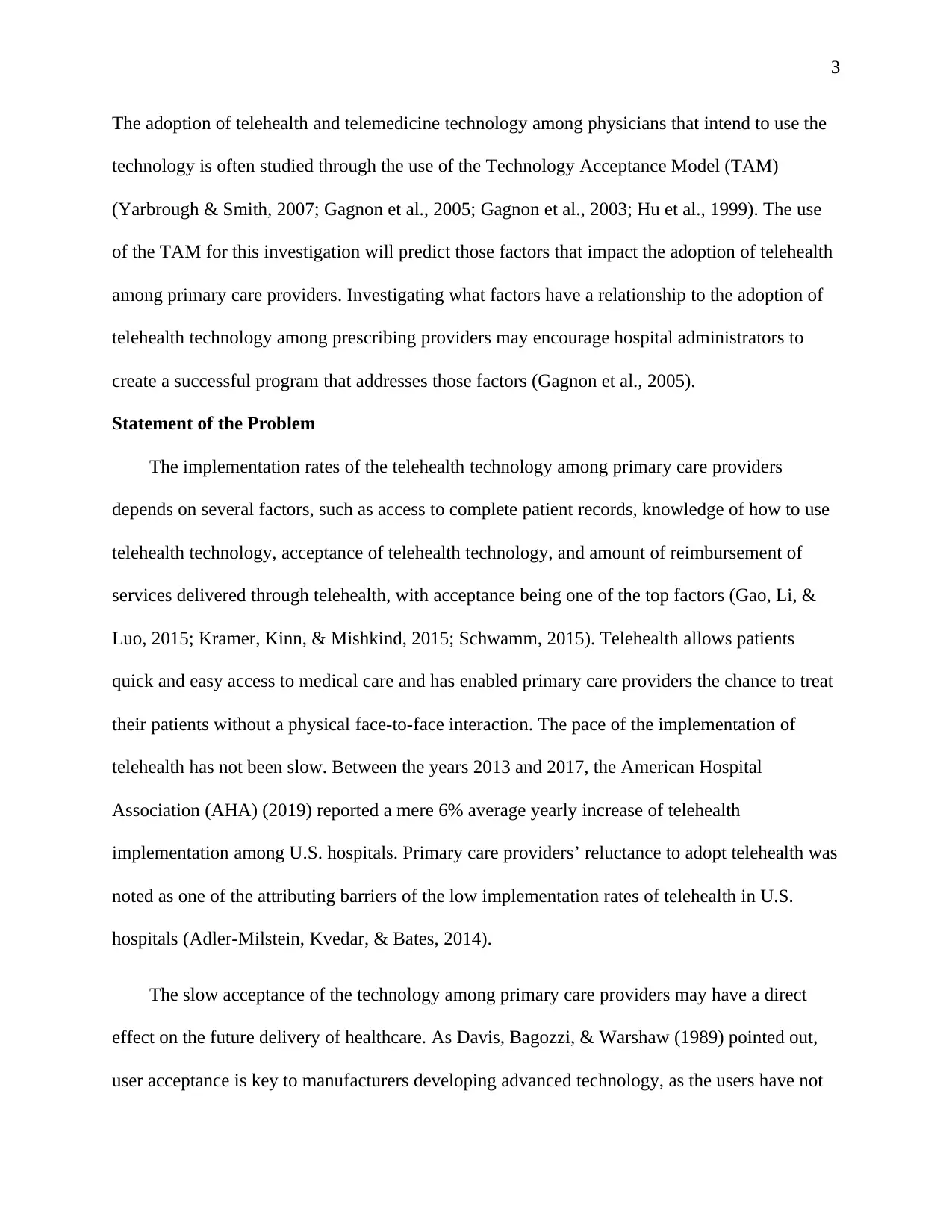
3
The adoption of telehealth and telemedicine technology among physicians that intend to use the
technology is often studied through the use of the Technology Acceptance Model (TAM)
(Yarbrough & Smith, 2007; Gagnon et al., 2005; Gagnon et al., 2003; Hu et al., 1999). The use
of the TAM for this investigation will predict those factors that impact the adoption of telehealth
among primary care providers. Investigating what factors have a relationship to the adoption of
telehealth technology among prescribing providers may encourage hospital administrators to
create a successful program that addresses those factors (Gagnon et al., 2005).
Statement of the Problem
The implementation rates of the telehealth technology among primary care providers
depends on several factors, such as access to complete patient records, knowledge of how to use
telehealth technology, acceptance of telehealth technology, and amount of reimbursement of
services delivered through telehealth, with acceptance being one of the top factors (Gao, Li, &
Luo, 2015; Kramer, Kinn, & Mishkind, 2015; Schwamm, 2015). Telehealth allows patients
quick and easy access to medical care and has enabled primary care providers the chance to treat
their patients without a physical face-to-face interaction. The pace of the implementation of
telehealth has not been slow. Between the years 2013 and 2017, the American Hospital
Association (AHA) (2019) reported a mere 6% average yearly increase of telehealth
implementation among U.S. hospitals. Primary care providers’ reluctance to adopt telehealth was
noted as one of the attributing barriers of the low implementation rates of telehealth in U.S.
hospitals (Adler-Milstein, Kvedar, & Bates, 2014).
The slow acceptance of the technology among primary care providers may have a direct
effect on the future delivery of healthcare. As Davis, Bagozzi, & Warshaw (1989) pointed out,
user acceptance is key to manufacturers developing advanced technology, as the users have not
The adoption of telehealth and telemedicine technology among physicians that intend to use the
technology is often studied through the use of the Technology Acceptance Model (TAM)
(Yarbrough & Smith, 2007; Gagnon et al., 2005; Gagnon et al., 2003; Hu et al., 1999). The use
of the TAM for this investigation will predict those factors that impact the adoption of telehealth
among primary care providers. Investigating what factors have a relationship to the adoption of
telehealth technology among prescribing providers may encourage hospital administrators to
create a successful program that addresses those factors (Gagnon et al., 2005).
Statement of the Problem
The implementation rates of the telehealth technology among primary care providers
depends on several factors, such as access to complete patient records, knowledge of how to use
telehealth technology, acceptance of telehealth technology, and amount of reimbursement of
services delivered through telehealth, with acceptance being one of the top factors (Gao, Li, &
Luo, 2015; Kramer, Kinn, & Mishkind, 2015; Schwamm, 2015). Telehealth allows patients
quick and easy access to medical care and has enabled primary care providers the chance to treat
their patients without a physical face-to-face interaction. The pace of the implementation of
telehealth has not been slow. Between the years 2013 and 2017, the American Hospital
Association (AHA) (2019) reported a mere 6% average yearly increase of telehealth
implementation among U.S. hospitals. Primary care providers’ reluctance to adopt telehealth was
noted as one of the attributing barriers of the low implementation rates of telehealth in U.S.
hospitals (Adler-Milstein, Kvedar, & Bates, 2014).
The slow acceptance of the technology among primary care providers may have a direct
effect on the future delivery of healthcare. As Davis, Bagozzi, & Warshaw (1989) pointed out,
user acceptance is key to manufacturers developing advanced technology, as the users have not
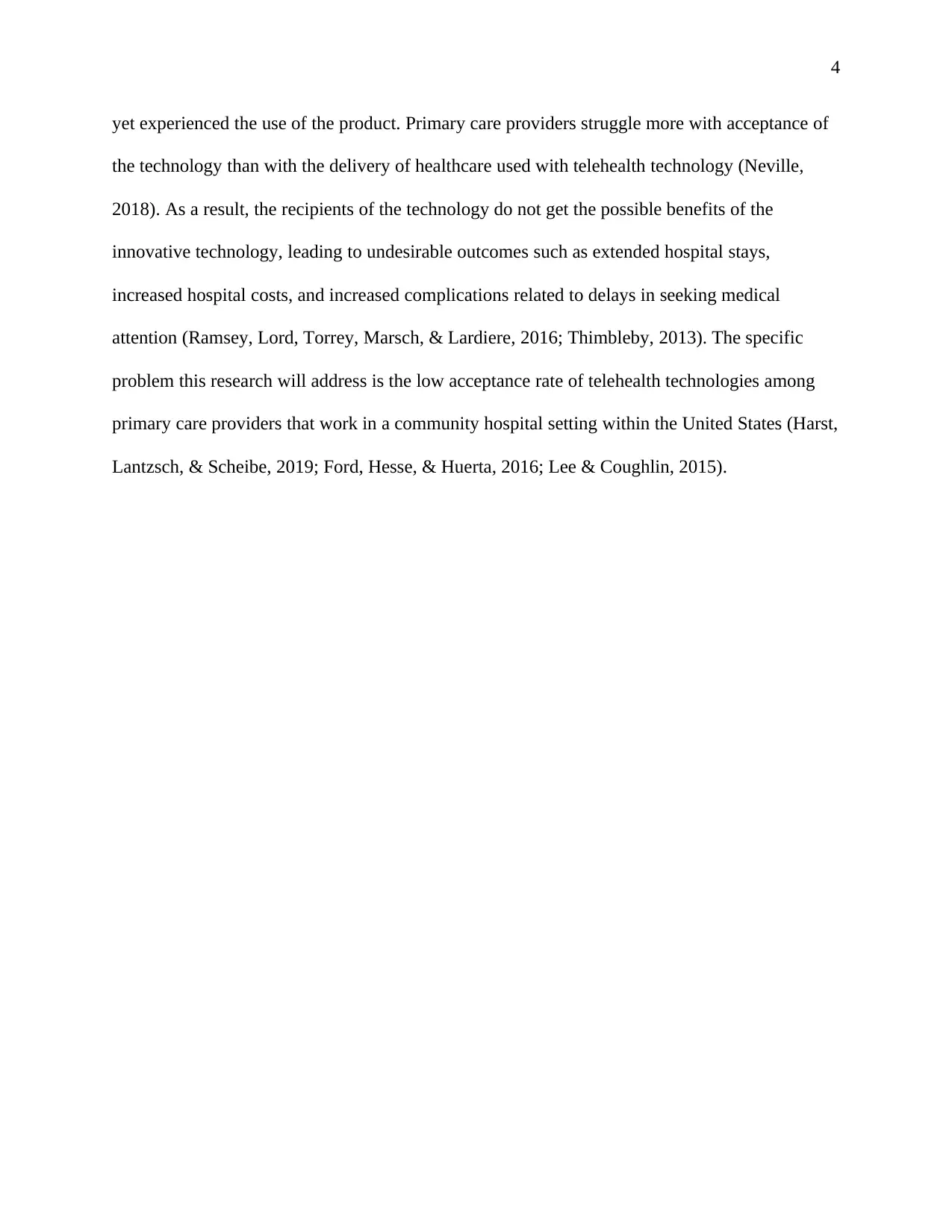
4
yet experienced the use of the product. Primary care providers struggle more with acceptance of
the technology than with the delivery of healthcare used with telehealth technology (Neville,
2018). As a result, the recipients of the technology do not get the possible benefits of the
innovative technology, leading to undesirable outcomes such as extended hospital stays,
increased hospital costs, and increased complications related to delays in seeking medical
attention (Ramsey, Lord, Torrey, Marsch, & Lardiere, 2016; Thimbleby, 2013). The specific
problem this research will address is the low acceptance rate of telehealth technologies among
primary care providers that work in a community hospital setting within the United States (Harst,
Lantzsch, & Scheibe, 2019; Ford, Hesse, & Huerta, 2016; Lee & Coughlin, 2015).
yet experienced the use of the product. Primary care providers struggle more with acceptance of
the technology than with the delivery of healthcare used with telehealth technology (Neville,
2018). As a result, the recipients of the technology do not get the possible benefits of the
innovative technology, leading to undesirable outcomes such as extended hospital stays,
increased hospital costs, and increased complications related to delays in seeking medical
attention (Ramsey, Lord, Torrey, Marsch, & Lardiere, 2016; Thimbleby, 2013). The specific
problem this research will address is the low acceptance rate of telehealth technologies among
primary care providers that work in a community hospital setting within the United States (Harst,
Lantzsch, & Scheibe, 2019; Ford, Hesse, & Huerta, 2016; Lee & Coughlin, 2015).
⊘ This is a preview!⊘
Do you want full access?
Subscribe today to unlock all pages.

Trusted by 1+ million students worldwide
1 out of 106
Related Documents
Your All-in-One AI-Powered Toolkit for Academic Success.
+13062052269
info@desklib.com
Available 24*7 on WhatsApp / Email
![[object Object]](/_next/static/media/star-bottom.7253800d.svg)
Unlock your academic potential
Copyright © 2020–2025 A2Z Services. All Rights Reserved. Developed and managed by ZUCOL.





